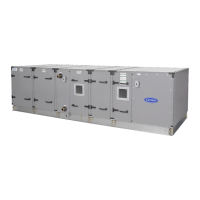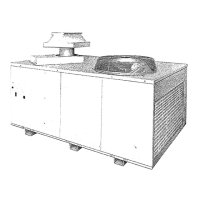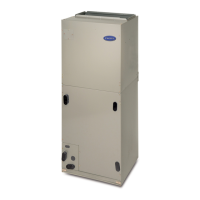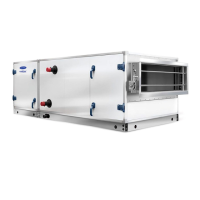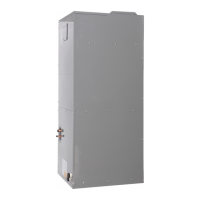137
Condensate Drain
Install a condensate-trapping drain line at the unit’s drain connec-
tion; use 1
1
/
2
-in. standard pipe. See Fig. 113 and 114 for correct
drain layout. Ensure adequate depth below base rail for the con-
densate trap. The condensate drain must not obstruct doors or cre-
ate a tripping hazard.
When calculating trap depth on draw-thru or blow-thru applica-
tions, remember that it is not the total static pressure but the up-
stream or downstream static resistance that is trapped against.
For instance, when calculating the trap depth for a cooling coil
condensate pan on the draw-thru side, trap against the coil pres-
sure drop in that coil section and any other pressure drops up-
stream of it.
Using Fig. 115 and 116, P
1
can be calculated to determine trap
depth height.
For the draw-thru example, P
1
is equal to the static pressure in the
cooling coil section plus all upstream static pressure, 2.5 inches.
To account for such fluctuations as dirty filters, 1 inch is added to
P
1
for the trap depth height (see Fig. 115).
Traps on draw-thru units must store enough condensate to prevent
losing the drain seal at start-up. The “
1
/
2
P
1
minimum” dimension
ensures that enough condensate is stored.
For the blow-thru example, P
1
is equal to the coil’s maximum
positive pressure which is the fan's external pressure of
2.3 inches minus any static pressure losses between the fan and
drain, in this case 1.2 in. wg from the cooling coil (see
Fig. 116).
For all units, provide condensate freeze-up protection as required.
On units with internal spring isolators, be sure the unit is mounted
to allow sufficient clearance for the required drain trap depth.
Marine drain pans are available but are recommended for use in
shipboard units only.
DRAW-THRU
Trap against all upstream static pressure including the drain pan
section (cooling coil section).
BLOW-THRU
Trap against the external static pressure of the fan only.
Fan Motor Wiring Recommendations
Motors are rated for use with variable frequency drives. Refer to
Table 34 for fan type and application. Full load amp (FLA) effi-
ciency and power factors are listed in Table 35.
Fig. 112 — Hot Gas Bypass Piping
a39-4439
LEGEND
ASC — Auxiliary Side Connector
TXV — Thermostatic Expansion Valve
Refrigerant Check Valve
Fig. 113 — Condensate Drain, Draw-Thru
Trapping (All Sizes)
a39-4307
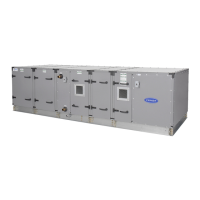
